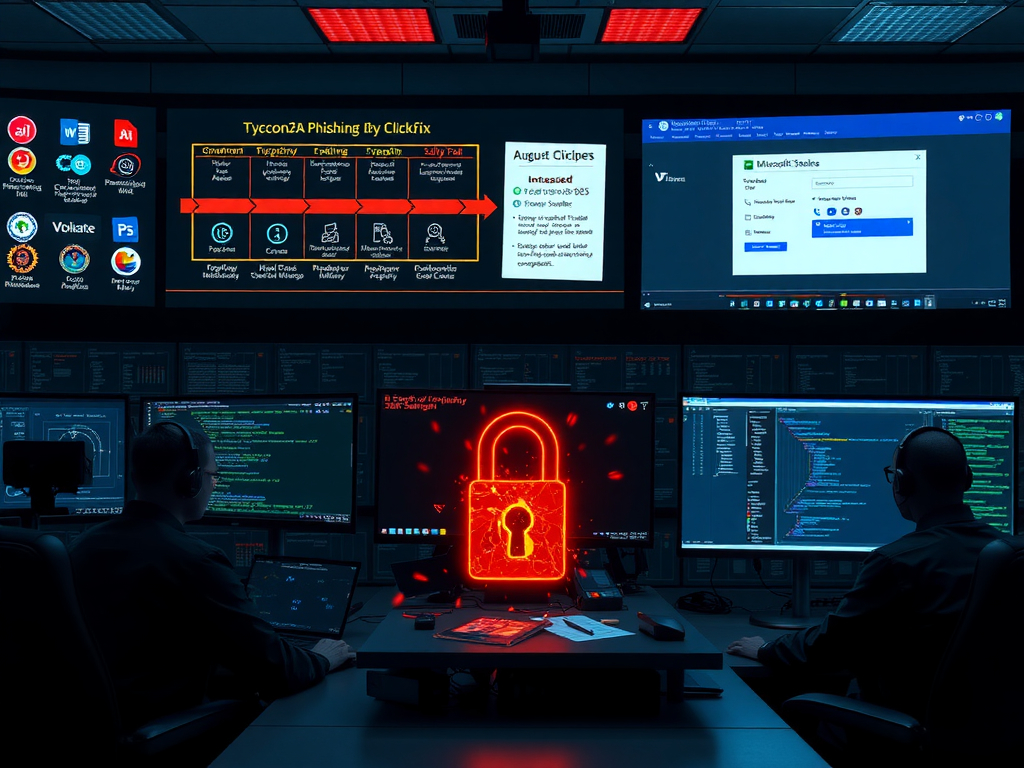Threat Report
Major August 2025 Cyber Attacks A detailed report on the significant cyber attacks in August 2025, including Tycoon2FA phishing, ClickFix campaign, and Salty2FA.
Threat Overview
In August 2025, several significant cyber threats emerged, posing substantial risks to government, military, financial institutions, and organizations across the US, UK, Canada, and Europe. These attacks highlight the evolving sophistication of cybercriminals and underscore the need for robust security measures.
Tycoon2FA Phishing Campaign
The Tycoon2FA phishing campaign is a sophisticated 7-stage attack targeting high-value sectors such as government, military, and financial institutions. This campaign employs multiple verification steps to bypass traditional security systems, making it particularly challenging to detect and mitigate.
ClickFix Campaign
The ClickFix campaign delivers the Rhadamanthys Stealer using PNG steganography, a technique that embeds malicious payloads within seemingly innocuous image files. This method demonstrates an increased level of sophistication in payload delivery, making it harder for security tools to identify and block.
Salty2FA Phishing-as-a-Service
Salty2FA is a new Phishing-as-a-Service framework attributed to the threat actor group Storm-1575. This framework targets Microsoft 365 accounts globally, capable of bypassing various two-factor authentication (2FA) methods. The discovery of Salty2FA emphasizes the need for continuous monitoring and advanced threat intelligence.
Detailed Analysis
The cyber threats observed in August 2025 demonstrate a significant evolution in phishing kits and stealers. These attacks leverage sophisticated techniques to evade detection and compromise targeted systems.
Tycoon2FA Phishing Campaign
The Tycoon2FA campaign is designed to exploit the trust placed in multi-factor authentication (MFA) systems. By incorporating multiple verification steps, attackers can bypass traditional security measures and gain unauthorized access to sensitive information.
ClickFix Campaign
The ClickFix campaign uses PNG steganography to deliver the Rhadamanthys Stealer. This technique involves embedding malicious code within image files, making it difficult for security tools to detect the payload. Once executed, the stealer can exfiltrate sensitive data from compromised systems.
Salty2FA Phishing-as-a-Service
Salty2FA is a comprehensive phishing framework that targets Microsoft 365 accounts. By bypassing various 2FA methods, attackers can gain access to user credentials and sensitive information. This framework is attributed to the threat actor group Storm-1575, known for its sophisticated cyber operations.
Recommendations for Mitigation
To mitigate the risks posed by these cyber threats, organizations should implement the following measures:
- Behavioral Analysis: Deploy behavioral analysis tools to detect and respond to suspicious activities in real-time. These tools can help identify anomalies that may indicate a phishing attack or malware infection.
- Real-Time Threat Intelligence: Utilize real-time threat intelligence feeds to stay informed about the latest cyber threats and vulnerabilities. This information can be used to proactively defend against emerging threats.
- User Awareness Training: Provide regular security awareness training to employees, focusing on recognizing phishing attempts and best practices for password security. Simulated phishing exercises can help reinforce these lessons.
- Multi-Factor Authentication (MFA): Implement strong MFA solutions that go beyond traditional methods. Consider using biometric authentication or hardware tokens to enhance security.
- Network Segmentation: Segment the network to limit lateral movement within the organization. This can help contain potential breaches and prevent attackers from accessing critical systems.
- Regular Updates and Patches: Ensure that all systems, software, and applications are kept up-to-date with the latest security patches. Regular updates help address known vulnerabilities that can be exploited by cybercriminals.
- Incident Response Plan: Develop and maintain an incident response plan to quickly detect, respond to, and recover from security incidents. This plan should include steps for containing the threat, investigating the incident, and restoring affected systems.


